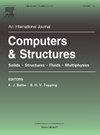考虑气动和几何非线性的基于深度学习的全桥颤振分析方法
IF 4.8
2区 工程技术
Q1 COMPUTER SCIENCE, INTERDISCIPLINARY APPLICATIONS
引用次数: 0
摘要
非线性效应随桥梁跨径的增大而增大。传统的线性颤振分析方法已逐渐不能满足研究和设计的需要。提出了一种基于深度学习的三维全桥颤振时域非线性分析方法。它考虑了包括空气静力效应在内的多种效应,以及结构的气动非线性和几何非线性。首先,基于长短期记忆(LSTM)网络建立了桥面截面非线性降阶气动模型;截面位移为输入,气动力为输出。气动数据通过CFD强迫振动数值模拟得到。其次,构建了三维全桥颤振分析框架。将降阶模型预测的气动力作为集中力施加在桥梁有限元模型的桥面节点上。采用重启技术实现动态迭代计算。通过改变瑞利阻尼,消除静风效应引起的初始激励对振型的影响,使桥梁提前达到静风平衡状态。最后,对一座三塔悬索桥进行了实例分析。采用该方法再现了全桥模型风洞试验中观测到的非线性颤振现象。分析了几何非线性对颤振现象的影响。该研究为准确评价桥梁的非线性颤振性能,进一步提高桥梁的抗风性能提供了重要参考。本文章由计算机程序翻译,如有差异,请以英文原文为准。
A deep learning-based method for full-bridge flutter analysis considering aerodynamic and geometric nonlinearities
The nonlinearity effect grows with the span length of the bridge. Traditional linear flutter analysis methods are gradually unable to meet research and design needs. This study proposed a time-domain nonlinear method for the 3D full-bridge flutter analysis based on deep learning. It considered multiple effects including aerostatic effect, as well as aerodynamic and geometric nonlinearities of the structure. Firstly, a nonlinear reduced-order aerodynamic model was constructed for the bridge deck section based on the long short-term memory (LSTM) network. The section displacement was the input, and the aerodynamic force was the output. The aerodynamic data were obtained from CFD numerical simulation of forced vibration. Next, the 3D full-bridge flutter analysis framework was constructed. The aerodynamic forces predicted by the reduced-order model were imposed as concentrated forces on the deck nodes of bridge finite element model. The restart technique was implemented to achieve the dynamic iterative calculation. The influence of the initial excitation caused by the static wind effect on the vibration mode was eliminated by changing Rayleigh damping to make the bridge reaches the static wind equilibrium state in advance. Finally, a case study on a triple-tower suspension bridge was performed. The nonlinear flutter phenomenon observed in the full-bridge model wind tunnel test was reproduced using the proposed method. The influence of geometric nonlinearity on the flutter phenomenon was analyzed. This study provides an important reference for accurately evaluating the nonlinear flutter performance of bridges and further improving their anti-wind performance.
求助全文
通过发布文献求助,成功后即可免费获取论文全文。
去求助
来源期刊

Computers & Structures
工程技术-工程:土木
CiteScore
8.80
自引率
6.40%
发文量
122
审稿时长
33 days
期刊介绍:
Computers & Structures publishes advances in the development and use of computational methods for the solution of problems in engineering and the sciences. The range of appropriate contributions is wide, and includes papers on establishing appropriate mathematical models and their numerical solution in all areas of mechanics. The journal also includes articles that present a substantial review of a field in the topics of the journal.
 求助内容:
求助内容: 应助结果提醒方式:
应助结果提醒方式:


